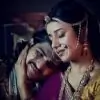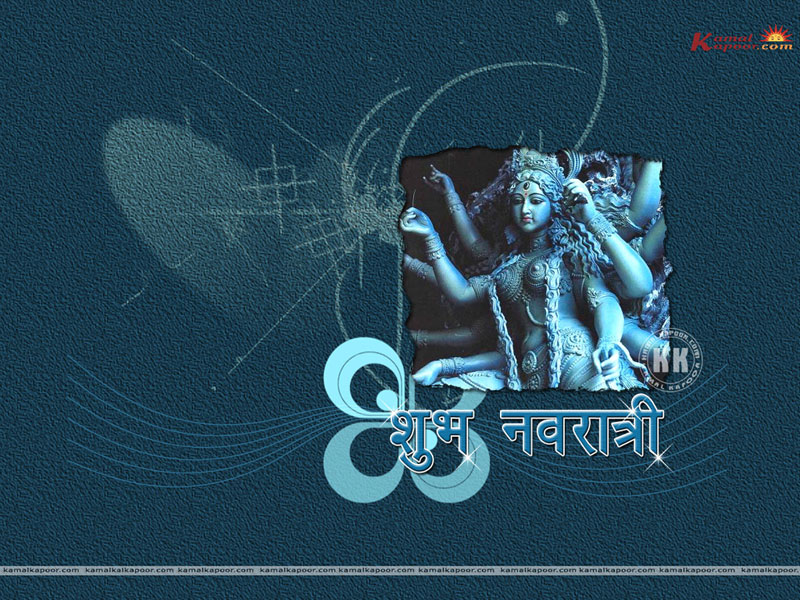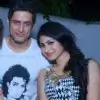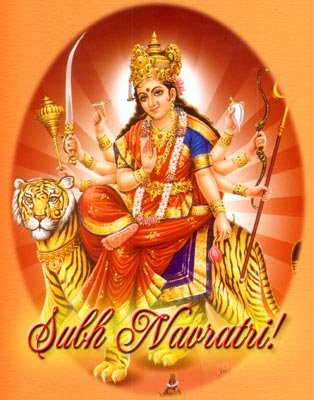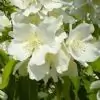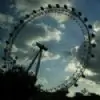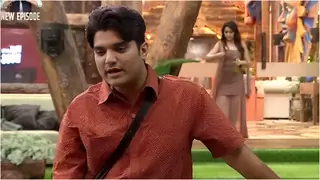
2. Brahmacharini - The second form of Goddess Durga is Brahamcharini. Here "Brahma" means "Tapa". The idol of this Goddess is very gorgeous. There is rosary in her right hand and Kamandal in left hand. She is full with merriment.
3. Chandraghanta - She is the third Shakti of Maa Durga. There is a half-circular moon in her forehead. She is charmful and bright. She is Golden color. She has three eyes and ten hands holding with ten types of swords - etc. weapons and arrows etc. She is seated on Lion and ready for going in war to fight the evil demons.
4. Kushmanda - The fourth Durga is Kushmanda. The Shakti creates egg, ie. Universe by mere laughing .She resides in solar systems. She shines brightly in all the ten directions like Sun. She has eight hands. Seven types of weapons are shining in her seven hands. Rosary is in her right hand.
5. Skandhamata - The fifth form of Durga is Skanda Mata. The daughter of Himalaya, after observing penance got married with Shiva. She had a son named "Skanda." Skanda is a leader of the army of Gods. Skanda Mata is a deity of fire. Skanda is seated in her lap. She has three eyes and four hands. She is white and seated on a lotus.
6. Kaatyayani - Katyayani is the sixth form of Maa Durga. The son of "Kat" as "Katya". Rishi Katyayan born in this "Katya" lineage. Katyayan had observed penance with a desire to get paramba as his daughter. As a result she took birth as a daughter of Katyayan. Therefore her name is "Katyayani" . She has three eyes and eight hands. These are eight types of weapons missiles in her seven hands. Her vehicle is Lion.
7. Kalaratri - This seventh Durga is black like night. Durga hairs are unlocked. She has put on necklaces shining like lightening. She has three eyes which are round like universe. Thousands of flames of fire come out while respiring from nose. She rides on Shava (dead body). There is sharp sword in her right hand. Her lower hand is in blessing mood. The burning torch (mashal) is in her left hand and her lower left hand is in fearless style, by which she makes her devotees fearless.
8. Mahagauri - The Eighth Durga is "Maha Gauri." She is as white as a conch, moon and Jasmine. She is of eight years old. Her clothes and ornaments are white and clean. She has three eyes. She rides on bull She has four hands. The above left hand is in "Fearless - Mudra" and lower left hand holds "Trishul." The above right hand has tambourine and lower right hand is in blessing style. She is calm and peaceful and exists in peaceful style. It is said that when the body of Gauri became dirty due to dust and earth while observing penance, Shiva makes it clean with the waters of Gangas. Then her body became bright like lightening.
9. Siddhiratri - The ninth and the final Durga is Siddhidatri. There are eight Siddhis , they are- Anima, Mahima, Garima, Laghima, Prapti, Prakamya, Iishitva & Vashitva. Maha Shakti gives all these Siddhies. This form of Durga is worshiped by all Gods, Rishis-Munis, Siddhas, Yogis, Sadhakas and devotees for attaining the best religious asset.

North India
The legend in North India goes that Mahishasura, the mighty demon, worshipped Lord Shiva and obtained the power of eternity. Soon, he started killing and harassing innocent people and set out to win all the three lokas. The gods in swargaloka appealed to Lord Shiva, to find a way to get rid of the demon. To protect the world from the atrocities of Mahishasura, the Trinity of Brahma, Vishnu and Shiva united their powers and created a divine female warrior, known as Goddess Durga. Mahishasura, when he saw the divine beauty of Goddess Durga, got mesmerized.
Eastern Belief
As per the legend prevalent in East India, Daksha, the king of the Himalayas, had a beautiful and virtuous daughter called Uma. She wished to marry Lord Shiva, since her childhood. In order to win over the Lord, she worshipped him and managed to please him as well. When Shiva finally came to marry her, the tiger-skin clad groom displeased Daksha and he broke off all the relationships with his daughter and son-in-law. One fine day, Daksha organized a yagna, but did not invite Lord Shiva for the same.
Uma got so angry at her father's rude behavior, towards her husband, that she decided to end her life by jumping into the agnikund of the yagna, where she was united with eternity (since then, she came to be known as Sati). However, she took re-birth and again won Shiva as her groom and peace was restored. It is believed that since then, Uma comes every year with Ganesh, Kartik, Saraswati and Laxmi and two of her best friends or 'sakhis', called Jaya and Bijaya, to visit her parent's home during Navratri.
Another Legend - Ram and Ravana
Yet another legend of Navratri relates to the Hindu epic Ramayana. It goes that Lord Rama worshipped Goddess Durga in nine aspects, for nine days, in order to gather the strength and power to kill Ravana. He wanted to release Sita from the clutches of powerful demon king Ravana, who had abducted her. Those nine nights became to be known as Navratri and the tenth day, on which Lord Rama killed Ravana, came to be called Vijayadashmi or Dusshera, signifying Rama's (good) triumph over Ravana (evil).









